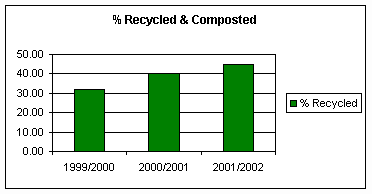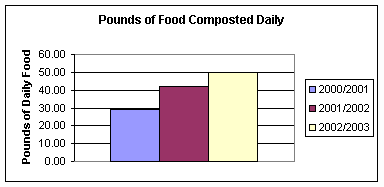Mansfield Middle School Compost Grant - Final Report
Abstract
In October 2000 the Mansfield Middle School, with a student population of 654 fifth through eighth graders, began composting their lunchtime food waste. This program, funded in part through a Connecticut Department of Environmental Protection (DEP) composting grant, now diverts approximately 9,000 pounds of food waste per year from trash incineration. A new web site and manual serve as resources for other schools and similar settings.
Program History and Description
In 1995 the first of Mansfield, Connecticut’s elementary schools began dabbling with the idea of composting food waste. By 1998 all three of the Mansfield elementary schools were composting their lunchtime food waste in a small commercial composter located at one of the elementary schools. Two years later, the Town of Mansfield’s public works department, on behalf of the Mansfield Middle School, applied for a Connecticut DEP organics recycling grant to expand the program to the middle school. The Town was awarded a $23,000 grant to implement a three-part project that included 1) the installation of compartmentalized compost bins at the Mansfield Middle School and promotion of the program, 2) development of a web site, and 3) publication of a "how-to" manual for Connecticut schools about starting their own composting program.
On October 30, 2000 the Middle School began composting. The 654 students attending the Middle School come primarily from the three elementary schools, where sorting lunchtime waste is a part of each student’s daily routine. The waste sorting set-up in the cafeteria includes a basin for eating utensils, one barrel for milk cartons, one barrel for cans and bottles, another for food waste and the last for all other waste. Trays are reusable and washed with the utensils daily. The kitchen also has a separate food waste barrel that they use to collect food preparation waste. Each day at the end of the lunch waves, a teacher and one or two students weigh the food waste, record the weight data, empty food waste into the composter, and cover it with a leaf/wood chip mixture. When the bin fills, the contents are moved (turned) into a wider neighboring compartment. By turning the pile oxygen is introduced around the food particles, leaves and wood chips which is essential to the microbes that are breaking them down into soil. A few teachers, the Town’s Recycling Coordinator and parents with their middle school children are the muscle behind moving the compost into larger bin compartments. The Town’s custodial and public works staff help by turning the piles in the wide compartments with a skid-steer loader. After several turns, when the composting process is finished, nutrient-rich compost is ready for use as a soil amendment.
Program Successes
The Middle School program provides congruency for the environmental ethic that is advocated in the elementary schools. The growing amount of food waste dumped into the food waste barrel coupled with the increased recycling rates and decrease in trash, seems to suggests a growing acceptance of the program. It is becoming part of the school community norm…a true testament to success.
 Prior to school composting, in school year 1999/2000, the Mansfield Middle School (MMS) recycled about 32% of its waste. The first year of MMS composting, 2000/01, the recycling rate went up 40%. In 2001/02, a rate of 45% recycling was achieved- out of all the waste generated at the school, 45% was either recycled or composted (Figure 1).
Prior to school composting, in school year 1999/2000, the Mansfield Middle School (MMS) recycled about 32% of its waste. The first year of MMS composting, 2000/01, the recycling rate went up 40%. In 2001/02, a rate of 45% recycling was achieved- out of all the waste generated at the school, 45% was either recycled or composted (Figure 1).
 Each student and adult is responsible for sorting his or her lunch waste into recycling, compost and trash barrels. Unlike recycling of traditional items, which is mandatory by state law and local ordinance, sorting food for the compost pile is strictly voluntary. Voluntary participation has grown each year. In the first year of the MMS composting program the daily average amount of food waste going into the composter was 29 pounds. In the second year the daily average jumped to 42 pounds of food waste and in the third year it appears to have leveled-out at about 50 pounds per day. Likewise, staff support has grown since the option of covering composting duty can be chosen in lieu of lunch duty (Figure 2).
Each student and adult is responsible for sorting his or her lunch waste into recycling, compost and trash barrels. Unlike recycling of traditional items, which is mandatory by state law and local ordinance, sorting food for the compost pile is strictly voluntary. Voluntary participation has grown each year. In the first year of the MMS composting program the daily average amount of food waste going into the composter was 29 pounds. In the second year the daily average jumped to 42 pounds of food waste and in the third year it appears to have leveled-out at about 50 pounds per day. Likewise, staff support has grown since the option of covering composting duty can be chosen in lieu of lunch duty (Figure 2).
There is a growing demand for the finished compost. Thanks to the promotional efforts of the composting team, staff members recognize its value. The first year’s compost was used to pot houseplants for the staff, and those who garden quickly snatched-up the rest. At the MMS plant sale, parents and residents are thrilled to take home buckets of free, screened compost.
With growing interest among schools around Connecticut to compost their lunchtime waste, so has the need for a guidance document to help them get started. Mansfield Middle School’s experience was seen as a low-tech, successful model on which to base such a document. As part of the grant, the Town’s Recycling Coordinator and a teacher/consultant authored the "how-to" manual, "School Composting: The Next Step in Recycling." The manual not only provides the nuts and bolts of bin construction and the composting process, but also delves deeper into often overlooked aspects that can help make an entire school composting program a success. These include gaining support from the school community and integration of composting into the curriculum through lessons and activities. The manual has an extensive list of resources with links, videos and books. The professionally designed manual can be downloaded from the CT DEP’s website or the Mansfield Middle School composting web page.
Websites have become an important vehicle for information transfer which is why Mansfield Middle School created the pages "Where Compost Happens" on their website. Like the manual, it was professionally designed and includes information about the composting process, activities, photos, links, fun facts and more.
In 2001 Mansfield Middle School received the Connecticut Green School Award from the Connecticut Recyclers Coalition for its exemplary waste reduction and recycling efforts.
Costs/Benefits
Supplies for the composting process and educational materials, underwritten by the composting grant, came to a total of $629. The tools that were purchased include a compost thermometer, industrial scale, rake, garden fork, tarp, pitch fork, compost collection containers, work gloves, shovels, and trowels. Educational materials used to promote composting included red wiggler worms for a worm bin, a book and two videos on composting.
The total materials cost for a seven-compartment steel-framed compost bin using recycled lumber was $2,600. The steel framing for the larger and wider bins and the use of recycled plastic lumber account for most of this cost. When selecting the materials for the compost bin, toxicity of the materials, durability, appearance and support of recycling by purchasing a recycled product were important considerations. Choosing plastic lumber as the primary material best matched all these criteria. It was more expensive than pressure-treated wood, but less than cedar. After the first year, it was determined that four 4' x 4' x 4' bins could not accommodate both active composting and storage of bulking materials for a school of 650 students. Three wider, stronger, steel-framed bins measuring 4' x 4' x 6' were built to allow for mechanical turning with a skid-steer loader. Two of the narrower bins are still used for composting and are turned by hand. The other two are used for storage of wood chips and leaves, keeping the area tidy.
After the initial cost, composting is low-cost to maintain. Public works or the custodial staff brings a truckload of leaves and wood chips to the school from the transfer station in the beginning of the school year. Each summer repairs are made to the compost bins primarily to keep out foraging animals. Public works has donated the labor and materials to repair torn hardware cloth, replace wood that has been nibbled through and refine the design of the compost compartments. Teachers, students, parents and Town staff volunteer their time for the routine and periodic tasks.
For each ton of food waste that is composted, the $62 trash incinerator tipping fee is avoided – a direct cost benefit of the program. The school’s recycling of other items has also risen because of the higher profile given to composting. This is an indirect benefit since the cost of recycling (container rental, hauling and tipping fees) is less than those same costs associated with trash. The recycling is collected once per month; whereas, the trash compactor is collected twice per month.
The cost for writing, designing, producing and replicating 2,000 manuals on CD ROM totaled $10,021.25. The professional design of the compost web pages cost $2,500.
Tips for Successful Replication at Other Schools
- Find a champion to spearhead the program
- Develop the program with a diverse committee that includes custodial staff, school administrators, teachers, parents, food service, public works staff.
- Make the daily composting routine a staff duty that can be done in lieu of bus duty, detention and/or cafeteria duty.
- Enlist parent/child (family) help in turning the compost.
- Publicize tangible success to the school community.
Program Summary
|
Sector |
Middle School |
|---|---|
|
Population |
654 students, 110 staff |
|
Start Date |
October 30, 2000 |
|
Dedicated Time |
3 hours per week – averaged over the year |
|
Responsibilities |
One recycling coordinator to arrange delivery of wood chips and leaves, arrange bin repairs, help with school promotion, arrange volunteers for turning the compost, turn the compost and screen it; Two teachers to arrange volunteers, help with daily tasks, turn compost and screen finished compost. |
|
Method |
Bin composting |
|
Materials Collected |
Lunchtime pre- & post-consumer food waste (encourage no meat or dairy) |
|
Food Discards Composted |
Approximately 9,000 pounds (4.5 tons) per year |
|
Average Avoided Tipping Fee |
$279 per year at $62 per ton |
|
Capital Expenditures |
$3,154 |
|
Indirect Benefits |
|
Recommendations for Improvements
The Mansfield Middle School offers a wealth of programs and exciting opportunities for its students. Where the elementary school green thumbs club (centered around their composting program) is an all-out success, the attempts to have a green thumbs club at the Middle School have been met with failure. Probably, in part, because of the wide selection of activities available at these grade levels.
A very small group of dedicated people manages the composting program. More staff committee members could enable the composting process to be tied into the curriculum and better promoted by offering prompt feedback and special events on America Recycles Day and Earth Day. It would have been to our advantage to start with a broader and larger base of support.
Contacts
| Virginia Walton Mansfield Recycling Coordinator Town of Mansfield 4 South Eagleville Rd Storrs, CT 06268 860-429-3333 |
Karen Burnham, teacher Mansfield Middle School 205 Spring Hill Rd Storrs, CT 06268 860- 429-9341 |
Composting | School Composting
Content Last Updated February 14, 2020

